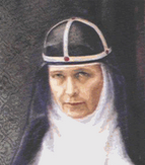News & Events

 Canonizing another Swedish saint
Canonizing another Swedish saint
It's been nearly 625 years since Sweden canonized its well-known saint, Saint Bridget (Birgitta). And now the country is preparing to celebrate the canonization of a second saint.
Maria Elisabeth Hesselblad was born in Fåglavik in Västergötland on June 4, 1870 and died in Rome in 1957, where she is buried at the House of St. Bridget. She worked as a nurse in the United States when she converted to Catholicism in 1902, then moved to Rome and became a nun.
Sister Elizabeth Hasselblad was known for rescuing several Jews in Rome during WWII and organizing a makeshift synagogue. After a life of service, getting venerated in 1991 and beatified in 2000, Pope Francis is now cannonizing her a saint. To become a saint requires a miracle to be linked to the person, a healing through prayer that can not otherwise be explained medically. Elizabeth Hasselblad's sainthood can be linked to, among other things, aiding Jews in WWII and at least two miracles.
"It is a powerful woman who has done something big and important not just here in Sweden but also in many other parts of the world,” says Anders Arborelius, Bishop of the Catholic Church in Sweden.
After Pope Francis began December's Catholic Church's jubilee in Rome, his representatives announced the plans on Dec. 17 to canonize Elisabeth Hesselblad, whose portrait already hangs in St Peter's Basilica in the Vatican.
"She is truly an example of concrete mercy. The State of Israel has recognized her — as one of few Swedes — awarded the Righteous Among the Nations," writes the Catholic Church in Sweden.
It is still not certain what date canonization will take place.
For more on Elisabeth Hesselblad, here is an excerpt from an article written for Nordic Reach:
The Most Extraordinary Woman In Rome
She gave Jewish people a hiding place during WWII, was good friends with Ingrid Bergman, and plays a crucial role in the Birgittine’s storyline. Yet few people have heard of Mother Elisabeth, whose life had all the makings of a Hollywood epic, poverty, struggles, glory. Mother Eunice points out a rather severe-looking portrait, but a photo from Mother Elisabeth’s youth reveals a lovely girl with pretty eyes, round cheeks and an air of heart-breaking innocence.
To understand Mother Elisabeth, it’s necessary to take a closer look at Saint Birgitta. One of the most powerful females of her time, Birgitta was a visionary who also had a finger in many political affairs in Sweden, as well as in Rome. A pious child, Birgitta married at an early age and gave birth to eight children. It wasn’t until she was widowed that the full force of her vocation became clear. She believed Christ himself appeared to her, penned down her visions, and journeyed to Rome where she struggled to get the Papacy to return to Rome from Avignon (which Pope Gregorius XI finally did in 1377).
Birgitta founded a new religious congregation, the Birgittines, with a monastery in Vadstena, Sweden. Through her good works she made herself loved in Rome, where she died in 1373. In 1391 she was canonized. It could’ve ended there, and almost did because the Reformation dealt a serious blow to the Birgittines. The Vadstena convent was dissolved and its nuns fled to Poland. The Birgittine Order was in hibernation, when along came Mother Elisabeth.
Born into a Lutheran household in a Swedish village as Maria Hesselblad in 1870, she immigrated to the U.S. alone at age 16 hoping to economically aid her family. In New York she become a nurse, and worked at the Roosevelt hospital. Hesselblad, who must have felt lonely and scared in her new country, had always been something of a seeker and in 1902 she converted to Catholicism. Two years later she moved to Rome, severely sick and prepared to die. Instead she managed to fulfill her dream of breathing life into Birgitta’s order. Despite poor health, extreme adversities and setbacks, Hesselblad continued with exceptional will power, completely absorbed with her goal to re-establish the Birgittines, which finally was carried out in 1911.
The Holy See gave her permission to use Casa di Brigida on Piazza Farnese (the house in which Saint Birgitta lived and died), and Hesselblad made it a center of activity for her newfound order. During WWII, she performed charity work on behalf of the poor and those who suffered because of racial laws, and was proclaimed Righteous Among the Nations, an award granted by Yad Vashem, the Holocaust Martyrs’ and Heroes’ Remembrance Authority to non-Jews who risked their lives to save Jews from the Holocaust.
A friend of Hesselblad, Marguerite Tjäder Harris, donated her childhood home, Vikingsborg in Darien, Connecticut to Hesselblad’s work and thus the first Birgittine sisters moved to Mother Elisabeth’s adopted country in 1957. In April that same year, Mother Elisabeth passed away. She is now on her way to saintliness: Pope John Paul II beatified her in 2000. Her canonization is pending. Her branch of Birgittines exists today in Sweden, England, Switzerland, Mexico, the Philippines, India and the U.S.
Back



